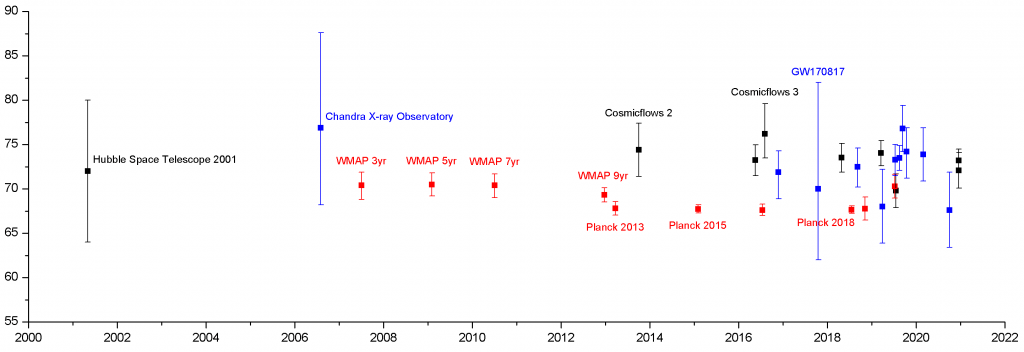Black Hole-Neutron Star Collisions Could Finally Settle the Different Measurements Over the Expansion Rate of the Universe
By Scott Alan Johnston
If you’ve been following developments in astronomy over the last few years, you may have heard about the so-called “crisis in cosmology,” which has astronomers wondering whether there might be something wrong with our current understanding of the Universe. This crisis revolves around the rate at which the Universe expands: measurements of the expansion rate in the present Universe don’t line up with measurements of the expansion rate during the early Universe. With no indication for why these measurements might disagree, astronomers are at a loss to explain the disparity.
The first step in solving this mystery is to try out new methods of measuring the expansion rate. In a paper published last week, researchers at University College London (UCL) suggested that we might be able to create a new, independent measure of the expansion rate of the Universe by observing black hole-neutron star collisions.
Let’s back up for a minute and discuss where things stand right now. When we look out into the Universe, galaxies that are further away appear to be moving away from us faster than closer ones, because space itself is expanding. This is expressed by a number known as the Hubble constant, which is usually written as the speed (in kilometers per second) of a galaxy one megaparsec (Mpc) away.
One of the best ways to measure the Hubble constant is to observe objects known as Cepheid Variables. Cepheids are stars that brighten and dim regularly, and their brightness just happens to line up with their period (the time it takes to dim and brighten again). The regularity of these objects makes it possible to estimate their distance, and a survey of many Cepheids gives us a Hubble constant of about 73km/s/Mpc. Type 1A supernovae are another common object with a known brightness, and they also give a Hubble constant hovering around 73km/s/Mpc.
On the other hand, you can measure the expansion of the Universe during its earliest phase by observing the afterglow of the big bang, known as the cosmic microwave background radiation (CMB). Our best measurement of the CMB was taken by the European Space Agency’s Planck spacecraft, which released its final data in 2018. Planck observed a Hubble constant of 67.66km/s/Mpc.

The difference between 67 and 73 isn’t enormous, and at first, the most likely explanation for the difference seemed to be instrument error. However, through subsequent observations, the error bars on these measurements have been narrowed down enough that the difference is statistically significant. A crisis indeed!
Here is where the UCL researchers hope to step in. They propose a new method of measuring the Hubble constant, which does not rely in any way on the other two methods. It begins with a measurement of gravitational waves: the ripples in spacetime caused by the collision of massive objects like black holes. The first gravitational waves were detected only recently, in 2015, and they haven’t yet been associated with any visible collisions.
As lead researcher Stephen Feeney explains, “we have not yet detected light from these collisions. But advances in the sensitivity of equipment detecting gravitational waves, together with new detectors in India and Japan, will lead to a huge leap forward in terms of how many of these types of events we can detect.”
Gravitational waves allow us to pinpoint the location of these collisions, but we need to measure light from the collisions too if we want to measure their speed. A black hole-neutron star collision might be just the type of event that would produce both.
If we see enough of these collisions, we could use them to produce a new measurement for the Hubble constant.

The UCL team used simulations to estimate how many black hole-neutron star collisions might occur in the next decade. They found that Earth’s gravitational wave detectors might pick up 3000 of them before 2030, and of these, about 100 of them will probably also produce visible light.
That would be enough. As such, by 2030 we just might have a brand-new measurement of the Hubble constant. We don’t know yet whether the new measurement will agree with the CMB measurement, or with the Cepheid/Type 1A measurement, or disagree with both. But the result, whatever it turns out to be, will be an important step in unraveling the puzzle. It could either put the crisis in cosmology to rest, or make it more serious, forcing us to look closer at our model of the Universe, and admit that there is more we don’t know about the Universe than we thought.
Learn More: “Black hole-neutron star collisions may settle dispute over Universe’s expansion.” UCL.
Stephen M. Feeney, Hiranya V. Peiris, Samaya M. Nissanke, and Daniel J. Mortlock, “Prospects for Measuring the Hubble Constant with Neutron-Star–Black-Hole Mergers.” Physical Review Letters.
Featured Image: A black hole devouring a neutron star. Credit: Dana Berry/NASA.
The post Black Hole-Neutron Star Collisions Could Finally Settle the Different Measurements Over the Expansion Rate of the Universe appeared first on Universe Today.

May 3, 2021 at 01:26AM
via Universe Today read more...

Post a Comment